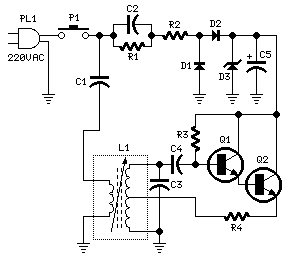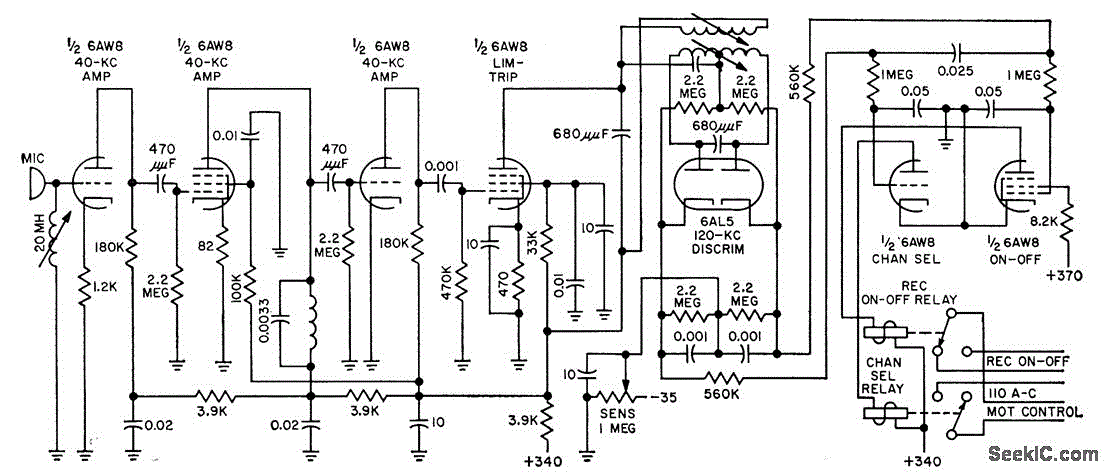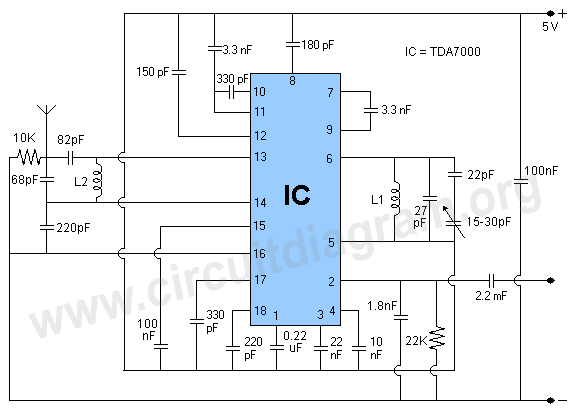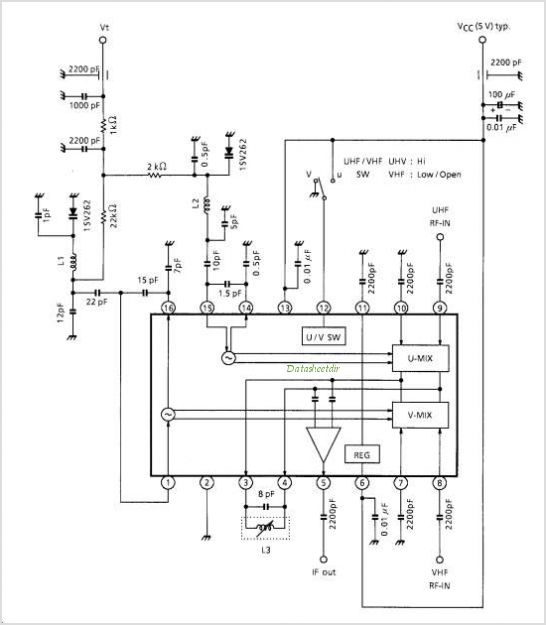
Infrared Remote Receiver Has Four Outputs
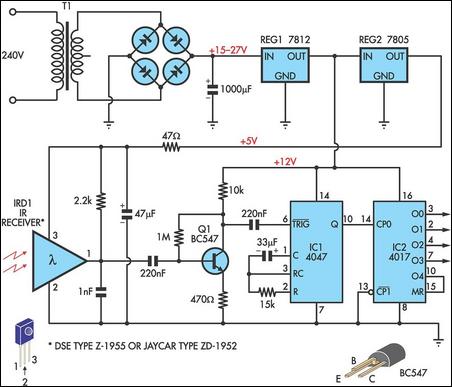
This circuit allows any infrared (IR) remote control to manage the outputs of a 4017 decade counter. It utilizes a 3-terminal IR receiver (IRD1) to capture infrared signals from the transmitter. The output from IRD1 is connected to an NPN transistor (Q1) through a 220nF capacitor. Transistor Q1 operates as a common-emitter amplifier with a gain of approximately 20, determined by the ratio of its 10kΩ collector resistor to its 470Ω emitter resistor. Q1 subsequently triggers IC1, a 4047 monostable, which generates clock pulses to the 4017 decade counter (IC2) each time a button on the remote control is pressed. If not all 10 outputs from IC2 are required, the first unused output can be connected to pin 15 (MR). In this configuration, only the first four outputs (O0-O3) of the counter are utilized, and the O4 output is linked to pin 15 to reset the counter on the fifth button press. The circuit is powered from the mains through a transformer and bridge rectifier, producing approximately 15-27V DC, which is then regulated to +12V and +5V supply rails using 3-terminal regulators REG1 and REG2.
The circuit operates by receiving infrared signals from a remote control, which are detected by the IR receiver (IRD1). The IR receiver outputs a low-level signal that is capacitively coupled to the base of the NPN transistor (Q1). The 220nF capacitor serves to filter out any DC bias, allowing only the AC component of the signal to pass through, effectively amplifying the signal strength. The common-emitter configuration of Q1 ensures that the amplified output can drive the subsequent circuitry without significant loss of signal integrity.
The 4047 monostable multivibrator (IC1) is configured to produce a pulse each time it receives a trigger from Q1. This pulse is then used to clock the 4017 decade counter (IC2), which counts the pulses and activates its outputs sequentially. The 4017 is designed to provide ten outputs, but in this application, it is limited to four outputs (O0-O3) for practical purposes. The reset mechanism is implemented by connecting the unused output (O4) to the reset pin (MR), ensuring that after the fourth button press, the counter resets and starts the counting sequence anew.
Powering the circuit is achieved through a transformer that steps down the mains voltage to a safer level, which is then rectified by a bridge rectifier to provide a stable DC voltage between 15 and 27V. This voltage is further regulated down to +12V and +5V using linear voltage regulators (REG1 and REG2), ensuring that the circuit components receive the appropriate voltage levels for optimal operation. The careful selection of resistors and capacitors in the circuit design guarantees reliable performance and efficient operation across a range of infrared remote control devices.This circuit enables any infrared (IR) remote control to control the outputs of a 4017 decade counter. It`s quite simple really and uses a 3-terminal IR receiver (IRD1) to pick up infrared signals from the transmitter.
IRD1`s output is then coupled to NPN transistor Q1 via a 220nF capacitor. Transistor Q1 functions as a common-emitter amplifier wi th a gain of about 20, as set by the ratio of its 10kO collector resistor to its 470O emitter resistor. Q1 in turn triggers IC1, a 4047 monostable which in turn clocks a 4017 decade counter (IC2). Basically, IC1 provides a clock pulse to IC2 each time a remote control button is pressed. If you don`t wish to use all 10 outputs from IC2, simply connect the first unused output to pin 15 (MR).
In this case, only the first four outputs (O0-O3) of the counter are used and so the O4 output is connected to pin 15 to reset the counter on the fifth button press. Power for the circuit is derived from the mains via a transformer and bridge rectifier which produces about 15-27V DC.
This is then fed to 3-terminal regulators REG1 & REG2 to derive +12V and +5V supply rails. 🔗 External reference
The circuit operates by receiving infrared signals from a remote control, which are detected by the IR receiver (IRD1). The IR receiver outputs a low-level signal that is capacitively coupled to the base of the NPN transistor (Q1). The 220nF capacitor serves to filter out any DC bias, allowing only the AC component of the signal to pass through, effectively amplifying the signal strength. The common-emitter configuration of Q1 ensures that the amplified output can drive the subsequent circuitry without significant loss of signal integrity.
The 4047 monostable multivibrator (IC1) is configured to produce a pulse each time it receives a trigger from Q1. This pulse is then used to clock the 4017 decade counter (IC2), which counts the pulses and activates its outputs sequentially. The 4017 is designed to provide ten outputs, but in this application, it is limited to four outputs (O0-O3) for practical purposes. The reset mechanism is implemented by connecting the unused output (O4) to the reset pin (MR), ensuring that after the fourth button press, the counter resets and starts the counting sequence anew.
Powering the circuit is achieved through a transformer that steps down the mains voltage to a safer level, which is then rectified by a bridge rectifier to provide a stable DC voltage between 15 and 27V. This voltage is further regulated down to +12V and +5V using linear voltage regulators (REG1 and REG2), ensuring that the circuit components receive the appropriate voltage levels for optimal operation. The careful selection of resistors and capacitors in the circuit design guarantees reliable performance and efficient operation across a range of infrared remote control devices.This circuit enables any infrared (IR) remote control to control the outputs of a 4017 decade counter. It`s quite simple really and uses a 3-terminal IR receiver (IRD1) to pick up infrared signals from the transmitter.
IRD1`s output is then coupled to NPN transistor Q1 via a 220nF capacitor. Transistor Q1 functions as a common-emitter amplifier wi th a gain of about 20, as set by the ratio of its 10kO collector resistor to its 470O emitter resistor. Q1 in turn triggers IC1, a 4047 monostable which in turn clocks a 4017 decade counter (IC2). Basically, IC1 provides a clock pulse to IC2 each time a remote control button is pressed. If you don`t wish to use all 10 outputs from IC2, simply connect the first unused output to pin 15 (MR).
In this case, only the first four outputs (O0-O3) of the counter are used and so the O4 output is connected to pin 15 to reset the counter on the fifth button press. Power for the circuit is derived from the mains via a transformer and bridge rectifier which produces about 15-27V DC.
This is then fed to 3-terminal regulators REG1 & REG2 to derive +12V and +5V supply rails. 🔗 External reference
